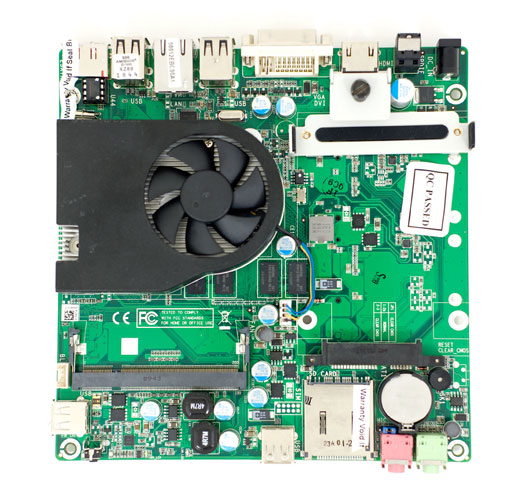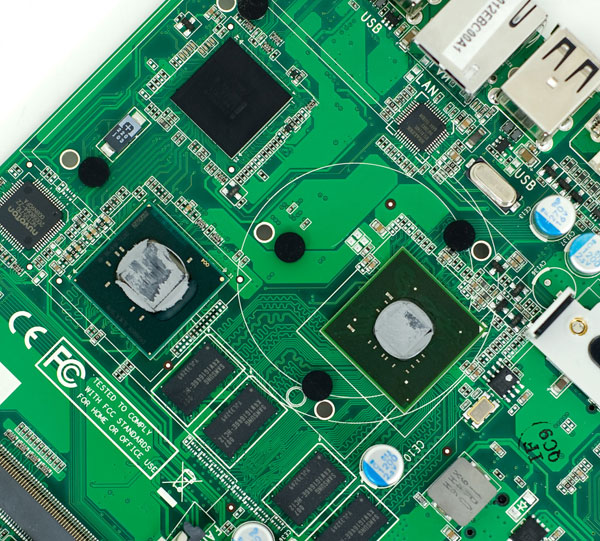Zotac ZBOX HD-ID11 Review: Next Gen ION is Better & Worse than ION1
by Anand Lal Shimpi on May 6, 2010 3:51 PM EST- Posted in
- GPUs
- Next Generation ION
- HD-ID11
- ZOTAC
- NVIDIA
Zotac’s ZBOX HD-ID11
Zotac struck gold with its first desktop mini-ITX ION board, and since then the company has been on a roll with very tiny, highly integrated motherboards and barebones systems designed for HTPC use.
The ZBOX is Zotac’s barebones small form factor system line. The HD-ID11 is the first ZBOX to use NVIDIA’s Next Generation ION paired with Intel’s Pine Trail Atom platform.

For $259.99 the HD-ID11 will give you a dual-core Atom D510, a 16-core GT218 GPU with 512MB of DDR3 memory, WiFi, a single 2.5” HDD/SSD bay and a single DDR2-800 SO-DIMM slot. Remember the memory controller here branches off the Atom D510 and it’s only a single channel 64-bit controller. The original ION used a dual-channel DDR2/DDR3 controller so you actually get less total memory bandwidth with this platform. Unlike the original ION however, the GPU gets its own dedicated frame buffer - so the CPU and GPU don’t have to share the bandwidth.
The chassis is all plastic, but it’s a fairly thick/dense plastic so it doesn’t feel overly cheap. I’d say we’re smack in the middle of the cheap to luxurious plastic spectrum.
You can lay the chassis flat or slide it into a stand and roll with it Wii-style. The front of the ZBOX has headphone and mic jacks, a SD card reader and a single USB port. You get network and drive activity indicators and a power button. Turning the machine on lights up a blue O on the top of the case.

On the side you get another USB port, and on the back you’ve got four more bringing the total count up to six. That’s more USB ports than a Mac Pro on something smaller than an old Xbox 360 HD-DVD drive.

You get DVI and HDMI outputs, 10/100/1000 Ethernet, eSATA and optical out. As I mentioned earlier, WiFi (802.11b/g/n) is included but there’s no external antenna. There are two antennas inside.
Getting inside the ZBOX is pretty easy. Remove two thumbscrews and push the cover away to reveal the spacious motherboard. Another thumbscrew will hold the 2.5” HDD/SSD in place.

The 2.5” bay (if you can call it that) is sort of in the thermal shadow of the CPU/GPU/chipset heatsink, and it does get warm during use. I’d strongly recommend using a SSD not only because it does keep the system cool, but it makes using an Atom far more bearable. Pairing a slow CPU with a slow hard drive doesn’t make things any better surprisingly enough. With an SSD however, it feels more like you’re using a slow CPU in a modern system rather than a slow machine.
On the other side of the motherboard you’ll find the WiFi card as well as an open mini PCI Express slot for expansion. Zotac uses two of the NM10’s PCIe lanes to feed these ports, leaving only a x1 lane for the NVIDIA NG-ION GPU.
The fan is audible under heavy CPU load but overall the system is pretty quiet. In a room that by itself had an ambient noise of 32dB(A) the ZBOX HD-ID11 measured 33 - 34dB(A) an inch away from the system while playing back H.264 content. If you’re sitting across the room you’d be hard pressed to hear it. Fire up a bunch of CPU intensive applications however and the tiny internal fan will spin up and get annoying very quickly. I measured as much as 55dB(A) an inch away from the system with the fan at full bore.

The NM10 Express chipset (top), Intel Atom D510 (left) and NVIDIA NG-ION GPU (right)
The more audible part of the system was actually the power adapter. I got a constant whine from the power brick whenever it was plugged in with the machine turned off. Zotac tells me that the shipping models will have a different power cable, and they can't reproduce the issue so perhaps it's a problem with my unit.
Wake on USB works...sort of. I can wake the ZBOX up with USB mouse hooked directly to the machine but when going through my iogear switch box no USB perhaps will wake the machine. On top of that, any keystrokes/mouse clicks I perform while the machine is asleep seem to get buffered and all fire as soon as I get back into Windows. Again this only happens going through my iogear KVM, a direct attached mouse works as expected.
















40 Comments
View All Comments
Shadowmaster625 - Friday, May 7, 2010 - link
Why would intel only give 4 pci express lanes? That's just retarded. Why would NVidia even mess with this atom? Why not just use the old atom? Its the same damn thing. Just do a LTB on the old atom. Nvidia should go BK for doing stupid crap like this.hpmoon - Friday, May 7, 2010 - link
Wow. So while we appreciate that Zotac sent an early review unit, they should have paid attention when most of us observed that it would be rather offensive to jack up the price a second time merely by gauging enthusiast interest. $209 --> $239 --> $259 = pissed off customers. Now that the reviews are eh, we're done with you. And it's gonna hit you hard when every reviewer bemoans how $260 is just the beginning, with $100 at a minimum in additional expense for the RAM and hard drive. For truth-in-advertising, let's get real: The HD-ID11 is just under $400.Moving along.
hemantha - Sunday, May 9, 2010 - link
From the power consumption page - "The XBMC Live image I installed doesn't seem to let the Atom cores underclock themselves to 600MHz". I think D510 doesn't support EIST. I believe only Atom Nxxx do. So unless motherboard supports undervolting, I don't think these can be made to run at lower clock speeds.Nathelion - Monday, May 10, 2010 - link
Is there any information on if/when a Nano-Ion combo will be out? Atom really isn't fast enough to catch my eye, and (C)ULV is too expersive.sucram03 - Tuesday, May 11, 2010 - link
Did you really just mention VIA? That's scary @_@Really, the whole fact that is unless costs are driven down, users are almost better off getting a cheap AMD Vision-powered laptop for approximately the same price. You can find some of those laptops on sale for <$450 and have Athlon II X2 M300 CPUs and Radeon HD 4200's, which are both good enough to accelerate any videos thanks to the new release of the 10.4 Catalyst version (H.264 decoding up to L5.1). And most have HDMI ports, bluetooth, 802.11n, the list goes on...
Add to that the general flexibility and portability of having a laptop (i.e. having a built-in display right there with the computer, having a battery), and although you will have higher energy usage, it is NOT going to be a major concern for most households when all you do is boot it up for playback.
Broadcom's chipset is interesting, but still is only able to decode up to L4.1 H.264 if I remember correctly. Nvidia's chipsets would be the BEST to use to enable CUDA decoding and remove pretty much all limitations on accelerating any kind of video, but if you're going to have to pay the same as what you could buy a laptop for (or more), then what's the use? IMHO, AMD appears to have positioned themselves in the middle if we're talking about the HTPC/movie playback department for a budget system. Cost, features, benefits all seem to be pointing to them for the best benefit possible.
CereKong - Monday, May 10, 2010 - link
Quote:While manufacturers can use all four PCIe 1.0 lanes coming off Intel’s NM10 Express chipset, most have chosen to use just one leaving the remaining lanes for things like WiFi. A single PCIe 1.0 lane can only provide 250MB/s of bandwidth in either direction, hardly enough for a modern GPU. It’s because of this limitation that the next-generation ION GPU could actually perform slower than the first ION.
Thus which manufacturers do provide motherboards with multiple lanes for the GPU - and if possible are there any differences performance wise?
SnazzyS - Thursday, May 13, 2010 - link
NewEgg sold out very quickly. Looks like Logic Supply has some in stock: http://www.logicsupply.com/products/zbox_hd_id11idokibovito - Friday, May 14, 2010 - link
Not quite sure there but I've been keeping my eyes on the Acer Revo 3610 which seems to basically be the same thing as this _without_ the cooling fan! Looking at benchmarks the new CPU is 5-10% faster (tops) and the GPU is not much faster either (because of the PCIe 1x lane). In some benchmarks both CPU and GPU are actually slower than ION1 (which has a Geforce 9400M instead of a GT218.I would prefer the new generation, even if it's just a spit faster (think VPDAU and VP3 vs. VP4). But that fan and seemingly no real life performance benefit keeps me looking back on the Revo, which is cheaper and a hardware that is known to work with XBMC and Linux without dirty patches and evening prayers.
I can't see why this "next-gen" thing is better or even more future proof, however I would like to. Anyone?
Thanks
coutch - Monday, May 24, 2010 - link
any word if the drivers released today (BETA 256) address the flash performance issue ?Jackie78 - Wednesday, July 28, 2010 - link
Which version of XBMC did you use, since I guess they do not officially support DXVA accelerated video.